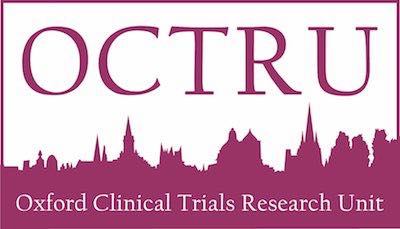Please note that OCTOVA is now closed to recruitment.
For entry into the OCTOVA trial all inclusion and exclusion criteria need to be fulfilled. Full details can be found in the protocol. A patient will be eligible for inclusion in this study if all of the following criteria apply.
Inclusion Criteria:
1. Female patients, age ≥ 16 years with relapsed epithelial ovarian, primary peritoneal or fallopian tube cancer who
have relapsed within 12 months of previous platinum-based therapy. Their most recent chemotherapy does not
have to have been platinum-based.
2. Patients can have received prior PARP inhibitor, but there must be a > 6 month interval since treatment.
3. Patients can have received prior antiangiogenic therapy, but there must be a > 6 month interval since treatment;
except for bevacizumab where a 6 week interval is required.
4. Measurable disease by RECIST Version 1.1 performed in past 4 weeks. At least one lesion, not previously
irradiated, that can be accurately measured at baseline as ≥ 10 mm in the longest diameter (except lymph
nodes which must have short axis ≥ 15 mm) with computed tomography (CT) or magnetic resonance imaging
(MRI) and which is suitable for accurate repeated measurements.
5. Sufficient archival tissue confirming histological diagnosis available.
6. ECOG PS 0-2
7. Able to swallow and retain oral medications.
8. Life expectancy > 12 weeks in terms of disease related mortality
9. Patient is willing and able to comply with the protocol for the duration of the study including undergoing
treatment and scheduled visits and examinations including follow up.
10. Written (signed and dated) informed consent prior to any study specific procedures and be capable of co-
operating with protocol.
11. Patients must have Haemoglobin ≥ 9.0 g/dL and no blood transfusions in the 28 days prior to randomisation
12. Patients must have normal organ and bone marrow function measured within 14 days prior to administration
of study treatment as defined below:
• Absolute neutrophil count (ANC) ≥ 1.5 x 10 9 /L
o No features suggestive of MDS/AML on peripheral blood smear
• White blood cells (WBC) > 3x10 9 /L
• Platelet count > 100 x 10 9 /L
• Total bilirubin ≤ 1.5 x institutional upper limit of normal (ULN)
• AST (SGOT)/ALT (SGPT) ≤ 2.5 x institutional upper limit of normal unless liver metastases are present in
which case it must be ≤ 5x ULN
• Serum creatinine ≤ 1.5 x institutional upper limit of normal (ULN) or calculated creatinine clearance >50
ml/min calculated using Cockroft-Gault, Jelliffe or Wright (see Appendix 4)
• Urine dipstick for proteinuria <2+. If urine dipstick is ≥ 2+ on two occasions more than one week apart
then a 24-hour urine must demonstrate ≤ 1 g of protein in 24 hours or protein/creatinine ratio < 1.5.
Exclusion Criteria:
1. Received previous single agent weekly paclitaxel for relapsed disease.
2. Pregnant or breast-feeding women or women of childbearing potential unless effective methods of
contraception are used during the trial and for 6 months after stopping treatment. Negative urine or serum
pregnancy test within 28 days of study treatment, confirmed prior to treatment on day 1. Pregnancy test will
be performed monthly in women of child bearing potential.
Postmenopausal is defined as:
• Amenorrheic for 1 year or more following cessation of exogenous hormonal treatments
• LH and FSH levels in the post-menopausal range for women under 50,
• radiation-induced oophorectomy with last menses >1 year ago,
• chemotherapy-induced menopause with >1 year interval since last menses,
• or surgical sterilisation (bilateral oophorectomy or hysterectomy).
3. Treatment with any other investigational agent, systemic chemotherapy, or participation in another
interventional clinical trial within 28 days prior to enrolment.
4. Radiotherapy within 2 weeks from the last dose prior to study treatment
5. Started a stable dose of bisphosphonates for bone metastases less than 4 weeks prior to treatment with
study drug e.g. patient is eligible and can continue to take bisphosphonates if these were started at least 4
weeks prior to treatment with study drug.
6. Concomitant use of known CYP3A4 inhibitors such as ketokonazole, itraconazole, ritonavir, indinavir,
saquinavir, telithromycin, clarithromycin and nelfinavir.
7. Concomitant use of potent inducers of CYP3A4 such as rifampicin, carbamazepine, phenobarbital,
phenytoin and St. John Wort.
8. Persistent toxicities (>=CTCAE grade 2) caused by previous cancer therapy with the exception of alopecia.
9. Resting ECG with QTc > 470msec on 2 or more time points within a 24 hour period or family history of long
QT syndrome.
10. Blood transfusions within 1 month prior to study start
11. Patients with myelodysplastic syndrome/acute myeloid leukaemia.
12. Patients with symptomatic, untreated, uncontrolled brain or meningeal metastases or tumour.
a. A scan to confirm the absence of brain metastases is not required.
b. Patients with radiological evidence of stable brain metastases are eligible, providing that they are
asymptomatic and:
i. Do not require corticosteroids, or
ii. Have previously been treated with corticosteroids, with clinical and radiological evidence of stabilisation at
least 10 days after discontinuation of steroids
iii. The patient can receive a stable dose of corticosteroids before and during the study as long as these were
started at least 28 days prior to treatment.
13. Major surgery within 14 days of starting study treatment
14. Patients who have not recovered from any effects of any major surgery.
15. Patients considered a poor medical risk due to a serious, uncontrolled medical disorder, non-malignant
systemic disease or active, uncontrolled infection. Examples include, but are not limited to, uncontrolled
ventricular arrhythmia, recent (within 3 months) myocardial infarction, unstable spinal cord compression
(untreated and unstable for at least 28 days prior to study entry), superior vena cava syndrome, extensive
bilateral lung disease on HRCT scan
16. Any psychiatric disorder that prohibits obtaining informed consent.
17. Left Ventricular Ejection Fraction (LVEF) < institutional lower limit of normal, when:
- Prior treatment with anthracyclines (excluding liposomal doxorubicin)
- Prior treatment with trastuzumab
- A NYHA classification of II controlled with treatment (see Appendix 2)
- Prior central thoracic RT, including RT to the heart
- History of myocardial infarction within the prior 12 months
18. Poorly controlled hypertension (persistently elevated > 150/100mmHg, either systolic or diastolic or both,
despite anti-hypertensive medication)
19. History of inflammatory bowel disease
20. History of cerebrovascular accident (including transient ischaemic attacks) within last 12 months.
21. Gastro intestinal impairment that could affect ability to take, or absorption of, oral medicines including sub-
acute or complete bowel obstruction
22. Evidence of severe or uncontrolled cardiac disease
23. Evidence of active bleeding or bleeding diathesis.
Defined as significant haemorrhage (>30mL bleeding/episode in previous 3 months) or haemoptysis (>5mL
fresh blood in previous 4 weeks)
24. Known treatment limiting hypersensitivity to cediranib, olaparib, paclitaxel or any of its excipients
25. Other psychological, social or medical condition, physical examination finding or a laboratory abnormality
that the Investigator considers would make the patient a poor trial candidate or could interfere with protocol
compliance or the interpretation of trial results.
26. Any other active malignancy, with the exception of adequately treated cone-biopsied in situ carcinoma of the
cervix uteri and non-melanoma skin lesions, requiring treatment/or whose prognosis will prevent readout from trial endpoints.
27. Patients who are known to be serologically positive for Hepatitis B, Hepatitis C or HIV.
28. Immunocompromised patients e.g., patients who are taking immunosuppressive drugs.







